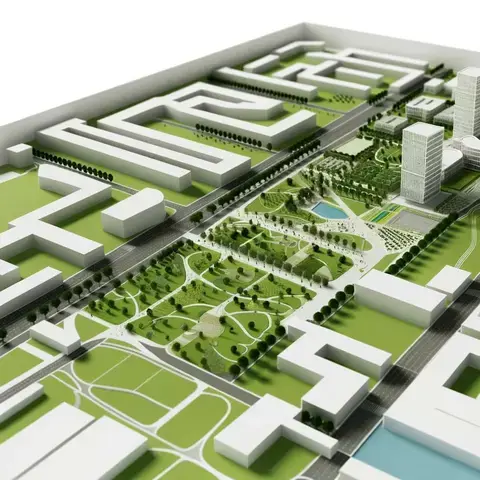Alternative Careers for Architects
Alternative Careers for Architecture Graduates - Exploring Diverse Opportunities in 2024

This article is written especially for architecture graduates looking into alternative career paths. While traditional roles in architecture firms are a common route, there are numerous other fields where the skills and knowledge of an architect can be highly valuable. This guide will introduce you to those opportunities, helping you leverage your architectural background in unique and fulfilling ways.
Summary: Jobs Related to Architecture and Construction

We'll explore a range of alternative careers, from the creative to the technical, that suit architecture graduates. By the end of this guide, you'll have a comprehensive understanding of various fields outside conventional architecture practice where you can apply your skills, including design, project management, and technology.
Section 1: Understanding Your Skills and Interests
- Identifying Your Strengths: Breakdown of key skills architecture graduates possess.
- Aligning Interests with Career Paths: How to match your passions with potential careers.
Alternative Careers for Architecture Graduates
Understanding Your Skills and Interests
Identifying Your Strengths
First, let's talk about the skills you've developed during your architectural studies. Architects are not just designers; they are problem solvers, creative thinkers, and strong communicators. You know how to use design software, understand building codes, and can visualize complex spaces. These skills are valuable in many fields, not just architecture.
For example, your problem-solving skills could make you an excellent project manager, while your design skills are transferable to fields like graphic design or even video game design. Understanding your strengths is the first step in finding a career path that excites you.
Aligning Interests with Career Paths
Now, consider what you're passionate about. Do you love the creative side of architecture, such as coming up with concepts and designs? Or are you more interested in the technical aspects, like making sure a building is sustainable and functional?
If creativity is your passion, careers in design, like industrial or interior design, might be a good fit. On the other hand, if you're interested in the technical side, you could explore roles in construction management or sustainability consulting.
Remember, the goal is to find a career that not only uses your skills but also aligns with your interests. This way, you're more likely to enjoy your work and be successful in your chosen field.
As an architecture graduate, you have a wide range of skills and interests that can lead to exciting career opportunities beyond traditional roles. By understanding your strengths and passions, you can find a career path that is both fulfilling and rewarding. Remember, the skills you've developed in architecture can open doors to many different fields. It's all about finding the right fit for you.
Section 2: Careers in Design
- Interior Design: Utilizing architectural skills in interior spaces.
- Urban Planning: Shaping cities and communities.
- Landscape Architecture: Designing outdoor and green spaces.
Example Projects and Key Figures
Careers in Design for Architects
Architects have skills that are in demand in many fields, not just in designing buildings. This part of our guide talks about how architects can use their skills in design-related careers. We will look at interior design, urban planning, and landscape architecture. For each area, we will give examples and mention people who have made a mark in these fields.
Interior Design

Architects know how to make spaces work and feel good. This skill is valuable in interior design. In this job, architects use their understanding of space, light, and materials to create functional and beautiful indoor environments.
Example: Consider how architects have designed the interiors of famous hotels, where every detail from the lobby to the rooms is thought out to ensure comfort and style.
Key Figures: Kelly Wearstler, known for her bold designs in hotel interiors, started with an architectural background.
Urban Planning

Urban planning is about making better cities and towns. Architects bring their knowledge of buildings, spaces, and how people use them to this field. They work on designing parks, arranging streets, and planning where buildings should go. Their goal is to make cities that are easy to live in and move around.
Example: The development of bicycle paths in Copenhagen is a great example. Planners used their understanding of urban spaces to create a city that is bike-friendly and reduces traffic congestion.
Key Figures: Jan Gehl, an architect, has been influential in making cities more livable by focusing on public spaces that prioritize people over cars.
Landscape Architecture

Landscape architecture is another field where architects can shine. It's about designing outdoor spaces like parks, garden, and public squares. Architects use their skills to blend nature and design, creating spaces that are not only beautiful but also serve the community and the environment.
Example: The High Line in New York City transformed an old railway into an elevated park. It's a prime example of landscape architecture that provides green space in a dense urban area.
Key Figures: Kathryn Gustafson is known for her work on award-winning projects like the Diana, Princess of Wales Memorial Fountain, showcasing the impact of landscape architecture.
Design careers offer architects a chance to use their skills in different ways. Whether it's making cozy living spaces, planning better cities, or creating green urban areas, architects have a lot to contribute. These fields allow architects to explore their creativity while making spaces that improve people’s lives.
Section 3: Technical and Technological Careers
- 3D Visualization and Rendering: Bringing designs to virtual life.
- Sustainable Design Consulting: Focusing on eco-friendly solutions.
- BIM Management: Spearheading the digital aspects of design and construction.
Example Projects and Software Tools
Technical and Technological Careers for Architects
Today's architecture isn't just about drawing on paper; it's deeply intertwined with technology. This section highlights how architects can venture into technical and technological fields. We'll explore careers in 3D visualization and rendering, sustainable design consulting, and Building Information Modeling (BIM) management. Each of these areas offers a unique way to apply architectural skills in a tech-driven environment.
3D Visualization and Rendering

Architects have a keen eye for detail and design, making them perfect for careers in 3D visualization and rendering. This role involves using software to create lifelike images and animations of buildings and spaces before they are built. It's a way to bring architectural designs to virtual life, helping clients and the public see and understand a project before construction starts.
Example Projects: Marketing visuals for real estate developments, animated walkthroughs of proposed public parks.
Software Tools: Autodesk 3ds Max, Blender, and SketchUp are popular tools for creating detailed 3D models and realistic renders.
Sustainable Design Consulting

With a growing focus on sustainability, architects can lead as sustainable design consultants. This career path focuses on eco-friendly solutions, helping projects achieve sustainability goals through energy efficiency, material selection, and green building practices. Architects in this field work closely with design teams to ensure buildings are both beautiful and kind to the planet.
Example Projects: Green certified office buildings, eco-friendly homes with minimal environmental impact.
Software Tools: Tools like Autodesk Revit and Sefaira help in analyzing building performance and sustainability metrics.
BIM Management
BIM management is at the forefront of digital design and construction processes. A BIM manager uses BIM software to create detailed digital models of buildings. These models go beyond visuals to include information about the materials, specifications, and timelines. It's about managing the entire lifecycle of a building, from design through construction to maintenance.
Example Projects: Large-scale infrastructure projects that require collaboration between multiple teams, complex structures needing precise coordination.
Software Tools: Autodesk Revit and Navisworks are essential for BIM managers, enabling detailed modeling and project coordination.
For architects passionate about technology, these careers offer exciting opportunities to apply their skills in new ways. Whether it's through creating stunning visualizations, advocating for greener buildings, or managing complex data with BIM, technology opens up a world of possibilities for architects to explore beyond traditional roles. These paths not only leverage architects' existing skills but also allow them to be at the cutting edge of design and construction technology.
Section 4: Project and Construction Management
- Construction Management: Overseeing building projects from start to finish.
- Real Estate Development: Blending design with business to create new spaces.
- Facility Management: Ensuring buildings operate efficiently post-construction.
Key Skills and Certification Programs
Project and Construction Management for Architects

Architects possess a unique blend of creativity, technical knowledge, and project oversight abilities. This makes them ideal candidates for careers in project and construction management. This section explores how architects can transition into roles that focus on overseeing building projects, blending design with business in real estate development, and ensuring that buildings operate efficiently through facility management.
Construction Management
Construction management is about guiding a building project from its conception to its completion. Architects in this role use their understanding of the building process, materials, and codes to ensure that projects are completed on time, within budget, and to the desired quality. They act as the bridge between the design team, contractors, and clients, coordinating every aspect of the construction process.
Key Skills: Effective communication, project scheduling, budget management, and understanding of construction laws and safety standards.
Certification Programs: Programs like the Certified Construction Manager (CCM) or Project Management Professional (PMP) can enhance an architect’s qualifications for construction management roles.
Real Estate Development
Architects with a knack for seeing the potential in spaces and a strong grasp of market trends can excel in real estate development. This career path involves identifying opportunities for new building projects or renovations and overseeing the design, financing, and construction processes. It's a chance to shape the built environment by blending architectural design with business acumen.
Key Skills: Market analysis, financial modeling, negotiation, and strategic planning.
Certification Programs: Earning a real estate development certificate or an MBA with a focus on real estate can provide a solid foundation for this career path.
Facility Management
Once a building is constructed, it needs to be maintained and operated efficiently. Facility management is about ensuring that buildings and their systems work well for the people who use them. Architects in facility management focus on optimizing the functionality of a building, managing maintenance, and improving sustainability and safety.
Key Skills: Knowledge of building systems, energy management, space planning, and regulatory compliance.
Certification Programs: Certifications such as the Certified Facility Manager (CFM) or Facilities Management Professional (FMP) are valuable for architects moving into this field.
Project and construction management offers architects the opportunity to apply their skills in dynamic new ways. Whether overseeing the construction process, developing new real estate projects, or managing the operation of completed buildings, architects can find rewarding careers in these fields. By developing additional skills and obtaining relevant certifications, architects can successfully transition to these roles, ensuring that buildings are not only well-designed but also well-built and well-maintained.
Section 5: Education and Communication
- Architecture Journalism: Writing and reporting on design and architecture trends.
- Teaching and Academia: Educating the next generation of architects.
Leading Publications and Educational Institutions
Education and Communication for Architects
Architects have the ability to not only create but also communicate complex ideas about design, space, and structure. This makes them well-suited for roles in education and communication, where they can share their knowledge and insights. In this section, we'll explore how architects can contribute to the fields of architecture journalism and teaching, highlighting the importance of leading publications and educational institutions in these areas.
Architecture Journalism
Architecture journalism involves writing, reporting, and analyzing trends in architecture and design. It's a way for architects to articulate their thoughts on current projects, innovations, and challenges within the industry. This role demands a deep understanding of architecture, an eye for detail, and the ability to engage a broad audience.
Key Skills: Strong writing skills, critical thinking, and a keen understanding of architectural trends and history.
Leading Publications: Well-known publications in this field include Architectural Digest, ArchDaily, and Dezeen, where architects can find inspiration, contribute articles, or even pursue careers as writers or editors.
Teaching and Academia
Many architects find fulfilling careers in academia, teaching the next generation of architects. This path allows them to share their expertise and experiences, shaping future professionals in the field. Teaching can range from technical skills, like drafting and modeling, to theoretical concepts, such as architectural history and sustainable design.
Key Skills: Deep knowledge of architectural concepts, effective communication, and a passion for mentoring students.
Leading Educational Institutions: Prestigious schools like the Massachusetts Institute of Technology (MIT), The Bartlett School of Architecture at University College London, and the Architectural Association in London are renowned for their architecture programs. These institutions often seek experienced architects to join their faculty.
Education and communication offer architects pathways to extend their impact beyond the drafting table. Through architecture journalism, architects can influence public opinion and contribute to the discourse on design and urban development. In academia, they have the opportunity to mold the minds of future architects, passing on the legacy of their knowledge and passion for the profession. Both fields provide meaningful ways for architects to share their expertise and continue learning and growing within the architecture community.
Section 6: Beyond the Traditional: Unconventional Paths
- Art Installation Design: Creating immersive art experiences.
- Video Game Design: Architectural design in virtual worlds.
- Set Design for Film and Television: Crafting visual stories through spaces.
Interviews with Professionals in Unconventional Roles
Beyond the Traditional: Unconventional Paths for Architects
The world of architecture extends far beyond buildings and urban planning. Many architects find their calling in less traditional roles, where they can apply their design skills and creative thinking in unique ways. This section explores unconventional career paths for architects, including art installation design, video game design, and set design for film and television. We’ll also share insights from professionals who have successfully ventured into these fields.
Art Installation Design
Art installation design allows architects to blend the boundaries between architecture, art, and experience. In this role, architects create immersive environments that engage audiences in novel ways. These installations can be found in galleries, public spaces, or at festivals and often involve a mix of physical and digital design elements.
Key Skills: Creative vision, understanding of materials, and an ability to create engaging spatial experiences.
Professional Insight: Many architects who move into art installation design cite the freedom to experiment with form and concept without the constraints of traditional building projects as a major draw.
Video Game Design
With the rise of digital environments, architects are increasingly in demand in the video game industry. Here, they apply their skills to design complex, interactive worlds that gamers navigate. This role requires a deep understanding of space, structure, and narrative, translating architectural principles into virtual landscapes.
Key Skills: Spatial awareness, 3D modeling skills, and a grasp of narrative design.
Professional Insight: Architects in video game design often highlight the joy of creating limitless worlds unbound by physical and financial constraints typical of real-world construction.
Set Design for Film and Television
Set design for film and television is another area where architects can shine. In this field, architects use their skills to create the physical backdrop against which stories unfold. This involves designing sets that reflect the mood, era, and atmosphere of the narrative, working closely with directors and cinematographers.
Key Skills: Strong visual storytelling, historical research abilities, and a collaborative spirit.
Professional Insight: Transitioning architects value the fast-paced nature of set design, where they see their visions come to life quickly and contribute directly to the storytelling process.
Interviews with Professionals in Unconventional Roles
To better understand these unconventional paths, we spoke with professionals who have made the transition. They shared insights on the challenges and rewards of their respective fields. Common themes include the importance of adaptability, the excitement of working on diverse projects, and the satisfaction of pushing the boundaries of traditional architecture.
Interviews
Interactive Exhibit Designer: Elena Gomez
Background: Elena transitioned from working as an architect in residential projects to designing interactive exhibits for museums.
Transition: “I was always intrigued by how people interact with spaces. Transitioning to exhibit design allowed me to blend my architectural skills with my passion for storytelling and interaction.”
Challenges: “One of the toughest parts was getting used to the scale and temporariness of exhibits compared to permanent structures. It’s a different mindset.”
Rewards: “There’s a joy in watching visitors engage with exhibits you’ve designed. It’s immediate feedback on your work, which is rare in architecture.”
Virtual Reality (VR) Architect: Tomás Herrera
Background: Tomás uses his architectural background to create realistic and immersive environments for VR applications.
Transition: “I’ve always been a tech enthusiast. Moving into VR was a way to explore how technology can expand the boundaries of traditional architecture.”
Challenges: “The learning curve for VR software was steep. It's one thing to design in 3D, but another to create spaces that people can explore interactively.”
Rewards: “The ability to build worlds without physical constraints is incredibly liberating. Plus, seeing people ‘walk’ through your designs in real-time is fantastic.”
Production Designer for Film: Naomi Clark
Background: After years in architectural practice, Naomi now designs sets and environments for movies and TV shows.
Transition: “I was drawn to film because it combines architecture, art, and storytelling. It was a chance to think about spaces in a narrative context.”
Challenges: “Adapting to the pace of the entertainment industry was a challenge. Projects move quickly, and designs are constantly evolving.”
Rewards: “Seeing a set you designed come to life on screen is unbelievably rewarding. It’s a very collaborative process, which I love.”
Key Insights:
Flexibility and Openness to Change: Successful transition into unconventional roles often requires a shift in perspective and openness to new ways of working.
Creative Fulfillment: While challenging, these roles offer unique opportunities to directly see the impact of one's work and engage with audiences in novel ways.
Leveraging Architectural Skills: The core skills acquired in architectural training, such as spatial design and an understanding of human interaction with spaces, are highly transferable and valuable.
Continuous Skill Development: Staying relevant in these unconventional paths means continually learning and adapting to new tools and methods.
These conversations with professionals in unconventional roles reveal a world of opportunities for architects willing to explore beyond traditional practices. Their experiences emphasize the importance of adaptability, the potential for creative satisfaction, and the continuous journey of learning and growth in these dynamic fields.
Architects have a wealth of opportunities to apply their skills and passions in unconventional roles. From creating art installations and designing virtual worlds to crafting the physical settings for film and television, these paths offer a creative outlet and the chance to reach new audiences. Through the insights of professionals in these fields, it's clear that architects can find fulfillment and success by exploring beyond the conventional boundaries of their discipline.
Modern Design Features: 2024 Insight
Introduction to Modern Design in Architecture
- Contemporary Homes & Modern Windows: How modern design principles are applied in today’s architecture.
Historical Context
- Evolution of Modern Windows: Tracing back the history and how it influences current trends.
- Contemporary vs. Traditional Windows: Understanding the differences and applications.
Modern Design Features: 2024 Insight
Modern Design in Architecture
As we step into 2024, modern design in architecture continues to evolve, reflecting changes in technology, environmental awareness, and lifestyle preferences. At the heart of modern architecture are principles like simplicity, functionality, and a strong connection between indoor and outdoor spaces. This section dives into how these principles manifest in contemporary homes, with a special focus on modern windows as a key element in today’s architectural designs.
Contemporary Homes & Modern Windows
Contemporary homes are known for their clean lines, open floor plans, and emphasis on natural light. Modern windows play a crucial role in achieving this aesthetic, offering not just views but also serving as architectural features that define the building's character. Large, floor-to-ceiling windows, minimalist frames, and innovative materials are hallmarks of modern window design. They not only enhance the visual appeal of homes but also improve energy efficiency and connect the indoors with the natural world outside.
Historical Context
Evolution of Modern Windows
The history of windows in architecture is a fascinating journey that mirrors changes in construction technologies, materials, and design philosophies over time. From the small, functional openings in medieval structures to the ornate windows of the Renaissance and beyond, each era brought its innovations. The advent of modern architecture in the 20th century, with pioneers like Frank Lloyd Wright and Ludwig Mies van der Rohe, saw windows transform from mere openings to integral components of architectural design, emphasizing transparency, light, and a seamless flow between interior and exterior spaces.
Contemporary vs. Traditional Windows
Understanding the differences between contemporary and traditional windows is key to appreciating their impact on architectural design. Traditional windows are often characterized by smaller panes, wooden frames, and decorative details that complement historical and classical aesthetics. In contrast, contemporary windows prioritize simplicity and functionality, featuring larger glass areas, slim profiles, and advanced materials like aluminum and fiberglass. These modern windows are designed to meet higher standards for energy efficiency, durability, and maintenance, aligning with the needs and values of today's homeowners.
As we look at the landscape of modern architecture in 2024, it's clear that the evolution of design features like windows plays a significant role in shaping contemporary homes. Modern windows not only reflect current trends in aesthetics and sustainability but also embody the principles of modern architecture by fostering light-filled, efficient, and harmonious living spaces. Understanding the historical context and the distinctions between contemporary and traditional windows offers valuable insights into the ongoing dialogue between past and present in architectural design.
Jobs Related to Architecture and Construction
27 Alternative Careers for Architects in 2024
Each section of this guide is crafted to provide a clear, direct understanding of the diverse opportunities available for architecture graduates beyond traditional roles. By exploring these alternative paths, you'll gain insights into how your unique skills and interests can lead to fulfilling careers in various fields.
Conclusion
- Preparing for the Future: Embracing change and innovation in your career.
- Continuous Learning and Adaptation: Resources for further education and skill development.
Preparing for the Future: Embracing Change and Innovation in Your Career
The architectural landscape is continuously evolving, shaped by technological advancements, environmental considerations, and shifting societal needs. Preparing for the future requires an openness to change and a willingness to innovate. As architects, embracing these shifts not only ensures relevance but also opens up new avenues for creativity and impact. The future of architecture promises exciting possibilities for those ready to explore beyond traditional boundaries and incorporate new design philosophies and materials into their work.
Continuous Learning and Adaptation: Resources for Further Education and Skill Development
Staying updated and competitive in the field of architecture necessitates a commitment to continuous learning and skill enhancement. Fortunately, a wealth of resources is available to support this journey. Online courses, workshops, and seminars offer insights into the latest trends and technologies. Professional organizations and conferences provide networking opportunities and exposure to cutting-edge research. Additionally, pursuing certifications in sustainable design, digital modeling, and project management can further bolster an architect's expertise and adaptability.
Investing in continuous education not only enriches an architect's skill set but also fosters a mindset of innovation and resilience. By actively seeking knowledge and embracing new challenges, architects can navigate the complexities of the modern world, driving positive change in the built environment and society at large. The future belongs to those prepared to adapt, learn, and lead in the ever-changing landscape of architecture.
This guide is crafted for architecture graduates looking to explore career paths outside the traditional architectural firm setting. It's common to start your career in an architecture firm, but there are many other opportunities where an architect's skills are valued. We'll guide you through these opportunities, showing you how to use your architectural background in new and rewarding ways.
Alternative Careers for Architects FAQs
Career Paths and Similar Occupations
Are you considering a career in architecture but curious about alternative paths and related occupations? Here, we address frequently asked questions about career paths and similar occupations in the field of architecture.
What are 3 occupations that are similar or related to being an architect?
Occupations: Urban Planner, Landscape Architect, Interior Designer.
Transferable Skills
What transferable skills do architects have?
Architects possess a diverse range of transferable skills that are valuable in various professions. These include problem-solving abilities, creative thinking, proficiency in technical drawing and drafting, project management expertise, and strong communication skills.
High-Paying Specialties
Which field in architecture makes the most money?
Owners of architecture firms, particularly those specializing in commercial and industrial projects, often earn the highest incomes. Additionally, specialties such as sustainable design and Building Information Modeling (BIM) management are known for offering lucrative opportunities within the field.
Types of Architects
How many types of architects are there?
There are several types of architects, each specializing in different areas of design and construction. These include residential architects, commercial architects, landscape architects, urban design architects, interior designers, and sustainable architects, among others.
Qualities of an Architect
What kind of person can be an architect?
Successful architects typically possess a combination of creativity, attention to detail, strong mathematical skills, and a passion for problem-solving and collaboration. The ability to think critically and innovate is also crucial in this field.
Rewarding Specializations
What is the best type of architecture job?
The best architecture job varies depending on individual interests and career goals. However, many architects find fulfillment in specialties such as sustainable architecture, urban design, and historic preservation, which offer unique challenges and opportunities for creativity.
Geographic Demand
Where is the highest demand for architects?
Currently, countries experiencing significant construction booms, such as China, the United Arab Emirates, and certain regions of the United States, have a high demand for architects. These areas offer abundant opportunities for architects to contribute to large-scale projects and urban development initiatives.
Specializing in Extreme Architecture
How do you become an extreme architect?
Becoming an extreme architect involves specializing in designing structures for challenging environments, such as underwater habitats, extreme climates, or even extraterrestrial habitats for space exploration. This requires additional training in environmental sciences, material engineering, and innovative design solutions to address unique challenges posed by extreme conditions.
FAQs: The Future of Architecture
Curious about the future of architecture in a world increasingly influenced by technology? Here, we explore common questions regarding the role of architects and the impact of artificial intelligence (AI) on the profession.
The Role of Architects in the Future
Is there a future for architects? Will architects be needed in 10 years?
Yes, there will always be a demand for architects. Despite advancements in technology, architects play a crucial role in designing sustainable, innovative, and human-centric spaces that meet the evolving needs of society.
The Influence of AI on Architecture
Will AI replace architects in the future? Will AI take over architects?
While AI technology has the potential to streamline certain aspects of the design process, it cannot replace the creativity, intuition, and critical thinking skills that architects bring to their work. Architects use AI tools as aids in design, but human insight and ingenuity remain essential in creating meaningful and functional spaces.
Addressing Concerns about AI
Are architects at risk from AI? What jobs AI can't replace?
Architects are not at risk of being replaced by AI. While AI can assist in tasks like drafting and generating design options, it cannot replace the nuanced understanding of human needs, cultural context, and aesthetic considerations that architects bring to their projects. AI also lacks the ability to empathize with clients and stakeholders, which is crucial in creating successful architectural solutions.
The Uniqueness of Human Creativity
Can AI truly replace architects?
No, AI cannot fully replace architects. Architecture is a deeply human-centered profession that involves not only technical expertise but also creativity, empathy, and an understanding of the social, cultural, and environmental context in which buildings are situated. While AI can augment certain aspects of the design process, it cannot replicate the holistic approach and innovative thinking that architects provide.
As technology continues to evolve, architects will adapt and integrate new tools into their practice. However, the core elements of creativity, critical thinking, and human-centered design will remain central to the profession. Architects will continue to shape the built environment, addressing complex challenges and creating spaces that enhance quality of life for individuals and communities.
FAQs: Education and Entry into the Profession
Interested in pursuing a career in architecture but unsure about the educational requirements and timing? Here are some common questions related to education and entry into the architectural profession.
Comparing Architecture and Engineering
Is architecture harder than engineering?
Both architecture and engineering are challenging fields that require a strong foundation in mathematics and physics. However, architecture also demands creativity, design skills, and an understanding of human needs and cultural context, making it a unique blend of technical and artistic disciplines.
Choosing Between Architecture and Engineering
Should I do architecture or engineering?
The decision between architecture and engineering depends on your interests and strengths. If you're passionate about creative design, aesthetics, and shaping the built environment, architecture may be the better fit for you. On the other hand, if you enjoy problem-solving, technical analysis, and optimizing structural systems, engineering might be a better choice.
Age and Entry into Architecture
How old are most architects?
Architects can be of any age, but many individuals enter the architectural profession after completing their formal education and licensure requirements. As a result, it's common for architects to begin their careers in their late 20s or early 30s.
Is it too late to become an architect?
Is 35 too late to become an architect? Is 25 too late to become an architect?
No, it's never too late to pursue a career in architecture. Many individuals enter the profession later in life after gaining relevant experiences and skills in other fields. The diverse backgrounds and perspectives they bring enrich the profession and contribute to innovative design solutions.
Entering the field of architecture involves a combination of education, practical experience, and licensure. Whether you're considering architecture or engineering, it's essential to choose a path that aligns with your interests, strengths, and long-term career goals. With dedication and perseverance, individuals of all ages can pursue a fulfilling career in architecture and make meaningful contributions to the built environment.
FAQs: Work Environment and Lifestyle
Curious about the work environment and lifestyle of architects? Here are some frequently asked questions that shed light on the challenges and rewards of being an architect.
Stress and Satisfaction in Architecture
Is an architect stressful?
Architecture can be demanding and stressful at times, particularly when facing tight deadlines and high expectations. However, many architects find fulfillment in overcoming challenges and seeing their designs come to life.
Respect for Architects
Why are architects so respected?
Architects are respected for their significant contributions to society. They play a crucial role in designing safe, functional, and aesthetically pleasing spaces that enhance the quality of life for individuals and communities. Their work has a lasting impact on the built environment and cultural heritage.
Passion for Architecture
Why do I love being an architect?
Many architects love their profession for the opportunity to unleash their creativity, solve complex problems, and leave a tangible legacy through their designs. The ability to shape the world around them and positively impact people's lives is a source of immense satisfaction and fulfillment.
Financial Success in Architecture
Can architects be billionaires? Can an architect become a millionaire?
While it's rare for architects to achieve billionaire status, becoming a millionaire is possible, especially for those who establish successful architectural firms or diversify into related business ventures. Financial success in architecture often depends on factors such as entrepreneurship, innovative design solutions, and effective management of projects and resources.
The field of architecture offers a dynamic and challenging work environment, where architects have the opportunity to make meaningful contributions to society while pursuing their passion for design and creativity. Despite the demands and uncertainties, many architects find immense satisfaction in their work and take pride in the positive impact they have on the built environment and communities.
FAQs: Comparative Questions
Confused about the relationship between architects and engineers? Here are some comparative questions to clarify the distinctions and collaborations between these two professions.
Roles and Hierarchy
Are architects above engineers?
In terms of project hierarchy, architects and engineers work collaboratively, each bringing their expertise to the table. Architects typically focus on the overall design vision, spatial planning, and aesthetics of buildings, while engineers specialize in the technical aspects such as structural integrity, mechanical systems, and electrical components. Both professions are essential to the successful realization of a project, with architects and engineers often working closely together to achieve the desired outcomes.
Terminology and Definitions
Is architecture called engineering?
No, architecture and engineering are distinct disciplines with different focuses and methodologies. Architecture primarily concerns the design and aesthetics of buildings, encompassing aspects such as spatial planning, functionality, and cultural context. Engineering, on the other hand, deals with the technical aspects of construction, including structural integrity, mechanical systems, and material science. While architecture and engineering share some foundational knowledge and may collaborate on projects, they represent separate fields of expertise.
FAQs: Miscellaneous
Curious about some miscellaneous aspects of architecture? Here are answers to common questions that cover famous architects, diverse design opportunities, employment sectors, and the future outlook of the profession.
Famous Architects
Who is the world's most famous architect?
Architects like Frank Lloyd Wright, Zaha Hadid, and Norman Foster are widely recognized as some of the most influential and celebrated figures in the field of architecture. Their innovative designs, iconic buildings, and lasting legacies have left a profound impact on the built environment.
Architectural Design Beyond Buildings
What do architects design other than buildings?
In addition to designing buildings, architects also engage in various other design endeavors, including landscapes, urban plans, interiors, furniture, and even virtual environments. Their creative expertise extends beyond physical structures to encompass a wide range of spatial experiences and solutions.
Employment Sectors for Architects
What are the top three industries that employ architects?
Architects find employment opportunities in diverse industries, with the construction sector, urban planning agencies, and interior design firms being among the top employers. Their skills in design, planning, and project management are valued across a broad spectrum of fields where spatial expertise is required.
Future of Architecture
Does architecture have a future?
Absolutely. As societies continue to evolve and develop, the demand for well-designed, functional, and sustainable spaces will only grow. Architects play a crucial role in shaping the built environment to meet the needs and aspirations of present and future generations. With advancements in technology, materials, and sustainability practices, architecture is poised to remain a dynamic and relevant profession in the years to come.
